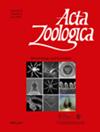利用形态计量学和小波分析法,基于耳石鉴定鳉鱼Aphaniops(腕足动物;鲤形目;Aphaniidae)的物种
IF 1.1
4区 生物学
Q4 ANATOMY & MORPHOLOGY
引用次数: 0
摘要
鳉鱼属有九个物种,分布在非洲东部和中东地区。然而,根据形态特征区分这些物种具有挑战性。在此,我们研究了耳石(sagittae)在区分 A. dispar、A. ginaonis、A. hormuzensis、A. kruppi 和 A. stoliczkanus 方面的作用。我们的方法以 89 个标本的耳石为基础,包括:(1)耳石形态计量学,遵循先前的建议;(2)基于离散小波变换的耳石轮廓形状分析--这是杀生鱼耳石研究中的一种新方法--以及比较统计分析。这两种方法都揭示了喙、反喙和外喙等耳石区域存在明显的种间差异。虽然方法(1)能有效区分大多数物种,但方法(2)却难以区分荷尔蒙鱼(A. hormuzensis)、斯托利茨卡努斯鱼(A. stoliczkanus)和克鲁皮鱼(A. kruppi)。此外,这两种方法在正确分类荷尔鲁津鱼时都遇到了挑战,因为在我们的样本中,该物种的耳石变异性很高。造成其变异性的可能因素是取样硫酸热泉(Khurgo)的环境波动和潜在的引种杂交。我们的结论是,耳石形态测量是鉴定 Aphaniops 物种的重要工具。此外,我们还发现,物种特异性耳石特征的独特性会随着物种的分化年龄而增加。本文章由计算机程序翻译,如有差异,请以英文原文为准。
Otolith‐based species identification in the killifish Aphaniops (Teleostei; Cyprinodontiformes; Aphaniidae) using both morphometry and wavelet analysis
The killifish genus Aphaniops consists of nine species distributed in Eastern Africa and the Middle East. However, distinguishing these species from each other based on morphological traits is challenging. Here we investigate the utility of otoliths (sagittae) in distinguishing between A. dispar , A. ginaonis , A. hormuzensis , A. kruppi and A. stoliczkanus . Our approach is based on otoliths from 89 specimens and involves (1) otolith morphometrics, following prior recommendations, (2) shape analysis of otolith contours based on discrete wavelet transformation—a novel method in killifish otolith research—and comparative statistical analyses. Both methods reveal significant interspecific variation in the otolith regions of the rostrum, antirostrum and excisura. While method (1) effectively discriminates most species, method (2) struggles to differentiate A. hormuzensis , A. stoliczkanus and A. kruppi . Additionally, both methods encounter challenges in correctly classifying A. hormuzensis due to the high otolith variability of this species in our sample. Possible factors accounting for their variability are environmental fluctuations at the sampled hot sulphuric spring (Khurgo) and potential introgressive hybridization. We conclude that otolith morphometry is a valuable tool for Aphaniops species identification. Furthermore, we found that the distinctiveness of species‐specific otolith traits increases with the divergence age of the species.
求助全文
通过发布文献求助,成功后即可免费获取论文全文。
去求助
来源期刊

Acta Zoologica
生物-动物学
CiteScore
2.90
自引率
8.30%
发文量
35
审稿时长
>12 weeks
期刊介绍:
Published regularly since 1920, Acta Zoologica has retained its position as one of the world''s leading journals in the field of animal organization, development, structure and function. Each issue publishes original research of interest to zoologists and physiologists worldwide, in the field of animal structure (from the cellular to the organismic level) and development with emphasis on functional, comparative and phylogenetic aspects. Occasional review articles are also published, as well as book reviews.
 求助内容:
求助内容: 应助结果提醒方式:
应助结果提醒方式:


